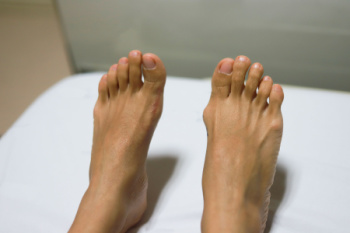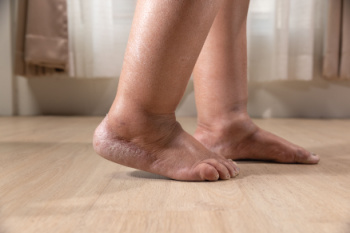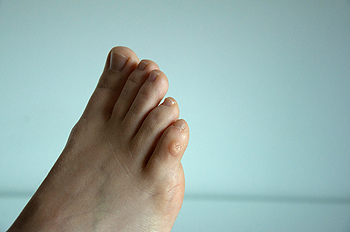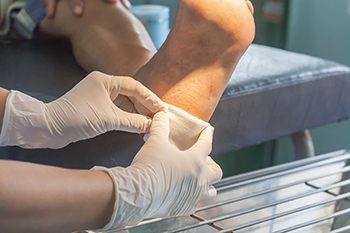
Tending to Bunions
 Bunions are bony bumps that form on the joint at the base of the big toe, causing the toe to deviate towards the other toes. They appear as swollen, protruding lumps on the side of the foot and can be red and tender. The condition can cause significant discomfort, including pain, swelling, and restricted movement of the big toe. Bunions often develop due to inherited foot structure, wearing tight or ill-fitting shoes, arthritis, or excessive stress on the feet. High heels and pointed shoes are common culprits in exacerbating bunions. Symptoms typically include pain, especially while walking, and inflammation surrounding the affected joint. Treatment for bunions ranges from conservative measures to surgery. Wearing wider shoes, using bunion pads, and taking anti-inflammatory medications can help to alleviate symptoms. Orthotic devices may help correct foot alignment. In severe cases, surgical intervention may be necessary to realign the bone and relieve pain. Untreated bunions can lead to complications such as bursitis or hammertoes. If you have a bunion that is causing you discomfort, it is suggested that you schedule an appointment with a podiatrist for treatment.
Bunions are bony bumps that form on the joint at the base of the big toe, causing the toe to deviate towards the other toes. They appear as swollen, protruding lumps on the side of the foot and can be red and tender. The condition can cause significant discomfort, including pain, swelling, and restricted movement of the big toe. Bunions often develop due to inherited foot structure, wearing tight or ill-fitting shoes, arthritis, or excessive stress on the feet. High heels and pointed shoes are common culprits in exacerbating bunions. Symptoms typically include pain, especially while walking, and inflammation surrounding the affected joint. Treatment for bunions ranges from conservative measures to surgery. Wearing wider shoes, using bunion pads, and taking anti-inflammatory medications can help to alleviate symptoms. Orthotic devices may help correct foot alignment. In severe cases, surgical intervention may be necessary to realign the bone and relieve pain. Untreated bunions can lead to complications such as bursitis or hammertoes. If you have a bunion that is causing you discomfort, it is suggested that you schedule an appointment with a podiatrist for treatment.
If you are suffering from bunions, contact Cecilia Capuano-King, DPM of New York. Our doctor can provide the care you need to keep you pain-free and on your feet.
What Is a Bunion?
A bunion is formed of swollen tissue or an enlargement of boney growth, usually located at the base joint of the toe that connects to the foot. The swelling occurs due to the bones in the big toe shifting inward, which impacts the other toes of the foot. This causes the area around the base of the big toe to become inflamed and painful.
Why Do Bunions Form?
Genetics – Susceptibility to bunions are often hereditary
Stress on the feet – Poorly fitted and uncomfortable footwear that places stress on feet, such as heels, can worsen existing bunions
How Are Bunions Diagnosed?
Doctors often perform two tests – blood tests and x-rays – when trying to diagnose bunions, especially in the early stages of development. Blood tests help determine if the foot pain is being caused by something else, such as arthritis, while x-rays provide a clear picture of your bone structure to your doctor.
How Are Bunions Treated?
- Refrain from wearing heels or similar shoes that cause discomfort
- Select wider shoes that can provide more comfort and reduce pain
- Anti-inflammatory and pain management drugs
- Orthotics or foot inserts
- Surgery
If you have any questions, please feel free to contact our office located in Smithtown, NY . We offer the newest diagnostic and treatment technologies for all your foot care needs.
Bunions
A bunion is an enlargement of the base joint of the toe that connects to the foot, often formed from a bony growth or a patch of swollen tissues. It is caused by the inward shifting of the bones in the big toe, toward the other toes of the foot. This shift can cause a serious amount of pain and discomfort. The area around the big toe can become inflamed, red, and painful.
Bunions are most commonly formed in people who are already genetically predisposed to them or other kinds of bone displacements. Existing bunions can be worsened by wearing improperly fitting shoes. Trying to cram your feet into high heels or running or walking in a way that causes too much stress on the feet can exacerbate bunion development. High heels not only push the big toe inward, but shift one's body weight and center of gravity towards the edge of the feet and toes, expediting bone displacement.
A podiatrist knowledgeable in foot structure and biomechanics will be able to quickly diagnose bunions. Bunions must be distinguished from gout or arthritic conditions, so blood tests may be necessary. The podiatrist may order a radiological exam to provide an image of the bone structure. If the x-ray demonstrates an enlargement of the joint near the base of the toe and a shifting toward the smaller toes, this is indicative of a bunion.
Wearing wider shoes can reduce pressure on the bunion and minimize pain, and high heeled shoes should be eliminated for a period of time. This may be enough to eliminate the pain associated with bunions; however, if pain persists, anti-inflammatory drugs may be prescribed. Severe pain may require an injection of steroids near the bunion. Orthotics for shoes may be prescribed which, by altering the pressure on the foot, can be helpful in reducing pain. These do not correct the problem; but by eliminating the pain, they can provide relief.
For cases that do not respond to these methods of treatment, surgery can be done to reposition the toe. A surgeon may do this by taking out a section of bone or by rearranging the ligaments and tendons in the toe to help keep it properly aligned. It may be necessary even after surgery to wear more comfortable shoes that avoid placing pressure on the toe, as the big toe may move back to its former orientation toward the smaller toes.
Why Ankles Can Hurt from Running

Running is an excellent way to stay fit, but it can sometimes lead to ankle pain. This discomfort often arises from overuse, improper footwear, or running on uneven surfaces. When you run, your ankles absorb significant impact with each step, which can strain the ligaments, tendons, and muscles around the joint. Overuse injuries occur when the ankle is repeatedly stressed without sufficient rest, leading to inflammation and pain. Wearing shoes that do not provide adequate support or cushioning can worsen this issue, as can running on surfaces that are too hard or uneven, increasing the risk of spraining the ankle. Additionally, biomechanical issues, such as improper running form or flat feet, can contribute to ankle pain by placing extra strain on the joint. To prevent ankle pain, it is important to wear proper running shoes and run on suitable surfaces. If you have developed ankle pain from running, it is suggested that you contact a podiatrist who can guide you toward relief and injury prevention tips.
Sports related foot and ankle injuries require proper treatment before players can go back to their regular routines. For more information, contact Cecilia Capuano-King, DPM of New York. Our doctor can provide the care you need to keep you pain-free and on your feet.
Sports Related Foot and Ankle Injuries
Foot and ankle injuries are a common occurrence when it comes to athletes of any sport. While many athletes dismiss the initial aches and pains, the truth is that ignoring potential foot and ankle injuries can lead to serious problems. As athletes continue to place pressure and strain the area further, a mild injury can turn into something as serious as a rupture and may lead to a permanent disability. There are many factors that contribute to sports related foot and ankle injuries, which include failure to warm up properly, not providing support or wearing bad footwear. Common injuries and conditions athletes face, including:
- Plantar Fasciitis
- Plantar Fasciosis
- Achilles Tendinitis
- Achilles Tendon Rupture
- Ankle Sprains
Sports related injuries are commonly treated using the RICE method. This includes rest, applying ice to the injured area, compression and elevating the ankle. More serious sprains and injuries may require surgery, which could include arthroscopic and reconstructive surgery. Rehabilitation and therapy may also be required in order to get any recovering athlete to become fully functional again. Any unusual aches and pains an athlete sustains must be evaluated by a licensed, reputable medical professional.
If you have any questions please feel free to contact our office located in Smithtown, NY . We offer the newest diagnostic and treatment technologies for all your foot and ankle needs.
Sports Related Foot And Ankle Injuries
Foot and ankle injuries are common among people who participate in sports. Several factors contribute to this. They include failing to stretch or warm up properly, not wearing the proper type of shoe and not taping or providing other types of support for the ankle or foot. The most common foot and ankle injuries suffered by people involved in sports are plantar fasciitis, ankle sprains and Achilles tendon damage or ruptures. If not treated properly, they can lead to permanent disability.
Treating these injuries is relatively simple if they are identified and addressed early. Many athletes dismiss the initial aches and pains associated with injury as just soreness or tired muscles. Their first response is usually to try to work through it. This can lead to serious problems. Many minor injuries are made far more serious when athletes continue to put strain and pressure on them. That attitude can change a mild strain into a serious strain and a minor tear into a rupture. Athletes should have unusual aches and pains evaluated by a skilled medical professional.
Plantar fasciitis is a painful injury. It is inflammation of the plantar fascia, the thick band of tissue running from the heel to the base of the toes. If left untreated, it can lead to a degenerative disease called plantar fasciosis. There are several effective treatments for this ailment. Doctors often prescribe rest, massages, stretching, night splints, physical therapy, anti-inflammatory medication, corticosteroids or surgery, usually in that order. The most effective treatment for plantar fasciitis is orthotics, which offers foot support. Surgery is occasionally used as a last resort, but it comes with the risk of nerve damage and infection and often does not stop the pain.
The Achilles tendon is the largest tendon in the body. It connects the calf muscles to the heel bone. Running, jumping and walking all impact this tendon. Two common injuries to the Achilles tendon are tendonitis and a rupture of the tendon. Tendonitis is inflammation in the tendon often caused by an increase in the amount of stress placed on it. Non-surgical treatments include rest, ice or anti-inflammatory medication. A rupture (tear) of the Achilles tendon can be treated by placing the lower leg in a cast for several weeks or with surgery. Many physicians feel surgery is the better option because it lowers the risk of re-ruptures. Both methods require 4 to 6 months of rehabilitation.
Ankle sprains are the most common sports related foot and ankle injury. A sprain occurs when the ligament holding the ankle bones and joint stretches beyond its normal range. It can be treated non-surgically with a combination of rest, ice wrapped around the joint for 30 minutes immediately after injury, compression by a bandage and elevating the ankle above the heart for 48 hours. This combination is referred to as RICE. Severe ankle sprains in which the ligaments are torn may require reconstructive surgery followed by rehabilitation.
Causes of Swelling in the Legs and Feet
 Edema in the legs and feet is a common condition characterized by swelling. The swelling is caused by excess fluid trapped in bodily tissues. Many factors can contribute to such swelling, like standing or sitting for long periods, which hinders proper blood flow. It also may stem from serious underlying health issues, including heart disease, kidney problems, or liver disease. Other contributing factors to edema include pregnancy, obesity, and certain medications that may cause fluid retention. Symptoms of edema include swollen, puffy skin that may feel tight. When the skin is pressed, it may also produce a dimple. There are many treatment options for edema, and a podiatrist, or foot doctor, is a specialist that can provide a personalized treatment plan. If you are affected by swollen feet and legs, it is suggested that you make an appointment with a podiatrist today for proper care.
Edema in the legs and feet is a common condition characterized by swelling. The swelling is caused by excess fluid trapped in bodily tissues. Many factors can contribute to such swelling, like standing or sitting for long periods, which hinders proper blood flow. It also may stem from serious underlying health issues, including heart disease, kidney problems, or liver disease. Other contributing factors to edema include pregnancy, obesity, and certain medications that may cause fluid retention. Symptoms of edema include swollen, puffy skin that may feel tight. When the skin is pressed, it may also produce a dimple. There are many treatment options for edema, and a podiatrist, or foot doctor, is a specialist that can provide a personalized treatment plan. If you are affected by swollen feet and legs, it is suggested that you make an appointment with a podiatrist today for proper care.
Swollen feet can be a sign of an underlying condition. If you have any concerns, contact Cecilia Capuano-King, DPM of New York. Our doctor can provide the care you need to keep you pain-free and on your feet.
Swollen feet are a common ailment among pregnant women and people who stand or sit for extended periods. Aging may increase the possibility of swollen feet and patients who are obese often notice when their feet are swelling too. There may be medical reasons why swollen feet occur:
- Phlebitis - A condition that causes the veins to become inflamed and can also cause leg pain.
- Liver disease - This may lead to low blood levels of albumin which is a protein. This can cause fluid in the blood to pass into the tissues and several areas of the body can become swollen.
- Heart failure - When the heart doesn’t pump properly the blood that is normally pumped back to the heart can pool in the veins of the legs causing swollen feet.
- Kidney disease - One of the main functions of the kidneys is releasing excess fluid in the body. This type of condition can make it difficult for the kidneys to function properly, and as a result the feet may become swollen.
- Deep-vein thrombosis (DVT)- This is a serious condition where blood clots form in the veins of the legs. They can block the return of blood from the legs to the heart which may cause the feet to swell. It is important to be treated by a podiatrist if this condition is present.
Swollen feet can also be caused by bone and tendon conditions, including fractures, arthritis, and tendinitis. Additionally, there may be skin and toenail conditions and an infection may cause the feet to swell. Patients who take medicine to treat high blood pressure may be prone to getting swollen feet.
Many patients elevate their feet to help relieve the swelling and this is generally a temporary remedy. When a podiatrist is consulted the reason behind the swelling can be uncovered and subsequently treated.
If you have any questions please feel free to contact our office located in Smithtown, NY . We offer the newest diagnostic tools and technology to treat your foot and ankle needs.
Swelling of the Feet
There are many reasons why patients experience swelling of the feet. It is rather common and may be a side effect of pregnancy or from sitting and standing for most of the day. Gravity could also play a role in the development of swollen feet. It is known that the weight of blood volume in our bodies is exerted on the veins in the legs and feet. The veins may not work as efficiently during the aging process, and this could make the blood flow backward causing swollen feet. Relief may be found when obese patients lose weight, and it may help to engage in compression therapy by wearing compression socks, stockings, or athletic sleeves. This method can release pressure on the feet and ankles which may help to reduce existing swelling. There are patients who have controlled their swollen feet by implementing healthy lifestyle changes. These can consist of reducing salt intake, incorporating a gentle exercise regime into the daily routine, and drinking plenty of fresh water. Swollen feet may be a temporary condition that affects people who travel via airplane or automobile, so it is beneficial to walk as frequently as possible even though it can be difficult. Swelling of the feet can also be indicative of other health issues so it is important to pay attention to any type of chest pain, mental confusion, dizziness, or fever. If you consistently have swollen feet, it is strongly suggested that you consult with a podiatrist who can help determine the cause and how to effectively treat it.
Professional Foot Corn Removal
 Corns are hard, thickened areas of skin that form on the feet in response to pressure and friction. They typically develop on the toes or the soles of the feet. These skin lesions can cause discomfort and pain, particularly when pressure is applied, such as while wearing shoes. Although corns form to protect the skin, they often grow too thick and need to be managed. A podiatrist, or foot doctor, can professionally remove corns through several methods. One common technique is carefully paring down the thickened skin using a scalpel. This should only be done by a professional to avoid injury. For persistent corns, a podiatrist may also use salicylic acid treatments to chemically pare down the excess skin. Additionally, custom orthotics or padding might be recommended to relieve pressure and prevent the recurrence of corns. In severe cases, a podiatrist may suggest surgical correction of the underlying bone structure that causes the friction. If you are struggling with foot corns, it is suggested that you visit a podiatrist for personalized and safe treatment.
Corns are hard, thickened areas of skin that form on the feet in response to pressure and friction. They typically develop on the toes or the soles of the feet. These skin lesions can cause discomfort and pain, particularly when pressure is applied, such as while wearing shoes. Although corns form to protect the skin, they often grow too thick and need to be managed. A podiatrist, or foot doctor, can professionally remove corns through several methods. One common technique is carefully paring down the thickened skin using a scalpel. This should only be done by a professional to avoid injury. For persistent corns, a podiatrist may also use salicylic acid treatments to chemically pare down the excess skin. Additionally, custom orthotics or padding might be recommended to relieve pressure and prevent the recurrence of corns. In severe cases, a podiatrist may suggest surgical correction of the underlying bone structure that causes the friction. If you are struggling with foot corns, it is suggested that you visit a podiatrist for personalized and safe treatment.
If you have any concerns regarding your feet and ankles, contact Cecilia Capuano-King, DPM of New York. Our doctor will treat your foot and ankle needs.
Corns: What Are They? and How Do You Get Rid of Them?
Corns can be described as areas of the skin that have thickened to the point of becoming painful or irritating. They are often layers and layers of the skin that have become dry and rough, and are normally smaller than calluses.
Ways to Prevent Corns
There are many ways to get rid of painful corns such as wearing:
- Well-fitting socks
- Comfortable shoes that are not tight around your foot
- Shoes that offer support
Treating Corns
Treatment of corns involves removing the dead skin that has built up in the specific area of the foot. Consult with Our doctor to determine the best treatment option for your case of corns.
If you have any questions please feel free to contact our office located in Smithtown, NY . We offer the newest diagnostic and treatment technologies for all your foot and ankle needs.
Corns: What Are They, and How Do You Get Rid of Them
Corns are thickened areas on the skin’s surface, to the point of being irritating and sometimes painful. Commonly found on the feet, corns are circular or cone-shaped. They develop where there are areas of pressure or friction, such as on the little toe when it rubs up against shoes, or on the ball of your foot.
Corns are often confused with a callus, but there is a difference between them. Corns can be raised bumps that are painful to the touch. They consist of a rough, thick area of skin that may be dry or waxy. Corns tend to be surrounded by skin that is inflamed, and are usually much smaller than calluses.
Removing the dead skin that has built up is the key in treating corns. Salicylic acid medication is most common in accomplishing this. The acid works by dissolving keratin, which is the protein that makes up the majority of corns. You can purchase salicylic acid over-the-counter in products such as wart removers. It comes in a variety of forms such as medicated pads, drops, or creams. However, people who are diabetic should not use salicylic acid, but should instead consult their doctor immediately.
According to the product directions, applying the medication directly onto the corn will treat it. The top layer of the corn will begin to turn white after use. When that occurs, the layers of skin can then be peeled away, making the corn smaller. Shaving off corns with razors or other pedicure equipment is never a good idea. This can lead to infection. If your corn gets infected, and is not treated immediately, a visit to the doctor will be necessary.
Another way to treat corns and help prevent their return is by using orthotic inserts, fitted by a podiatrist. Inserts fit right into your shoes and adjusts the way your foot fits into your shoes. This fixes the way you walk. This will lower your chances of getting corns, and eliminate current corns by reducing rubbing from friction.
Surgery is rarely used to treat corns, but does occur on occasion. Surgery actually deals with the underlying issue that causes corns. During surgery, the bone is shaved and any abnormalities are corrected, thus reducing the amount of friction that occurs during walking.
To prevent corns, the first step is reducing friction. Always wear shoes that fit well and don’t rub your feet. Pads can be purchased if you notice rubbing developing. These pads can be purchased over-the-counter, and can be simply placed on the irritated area. Wearing cushioned insoles in your shoes can always reduce the friction, and making sure to wear well-fitting shoes. This will ensure that your foot is not being squeezed awkwardly, and prevent corns from forming in the first place.
Healing of Foot Ulcers

Foot ulcers are open wounds that occur on the bottom of the foot or around the toes. They can range in size from small sores to larger, more severe wounds. These ulcers develop from a combination of medical factors, such as poor circulation, nerve damage, and high blood sugar levels, particularly in individuals with diabetes. Additionally, non-medical reasons like improper footwear, foot deformities, and injuries can contribute to their formation. Diagnosis involves a thorough examination by a podiatrist, often including tests to assess blood flow and nerve function. Foot ulcers differ from other skin conditions by their depth and potential to worsen if left untreated, leading to serious complications like infection or even amputation. If you have a foot ulcer, it is strongly suggested that you schedule an appointment with a podiatrist for prompt treatment, which may involve wound care, infection management, pressure relief, and addressing related underlying medical conditions.
Wound care is an important part in dealing with diabetes. If you have diabetes and a foot wound or would like more information about wound care for diabetics, consult with Cecilia Capuano-King, DPM from New York. Our doctor will assess your condition and provide you with quality foot and ankle treatment.
What Is Wound Care?
Wound care is the practice of taking proper care of a wound. This can range from the smallest to the largest of wounds. While everyone can benefit from proper wound care, it is much more important for diabetics. Diabetics often suffer from poor blood circulation which causes wounds to heal much slower than they would in a non-diabetic.
What Is the Importance of Wound Care?
While it may not seem apparent with small ulcers on the foot, for diabetics, any size ulcer can become infected. Diabetics often also suffer from neuropathy, or nerve loss. This means they might not even feel when they have an ulcer on their foot. If the wound becomes severely infected, amputation may be necessary. Therefore, it is of the upmost importance to properly care for any and all foot wounds.
How to Care for Wounds
The best way to care for foot wounds is to prevent them. For diabetics, this means daily inspections of the feet for any signs of abnormalities or ulcers. It is also recommended to see a podiatrist several times a year for a foot inspection. If you do have an ulcer, run the wound under water to clear dirt from the wound; then apply antibiotic ointment to the wound and cover with a bandage. Bandages should be changed daily and keeping pressure off the wound is smart. It is advised to see a podiatrist, who can keep an eye on it.
If you have any questions, please feel free to contact our office located in Smithtown, NY . We offer the newest diagnostic and treatment technologies for all your foot care needs.
Wound Care
Diabetics must be wary of all wounds, regardless of depth or size. Diabetes, a chronic disease in which the body cannot properly use glucose the way it normally would, causes various complications that make wounds difficult to heal. Nerve damage or neuropathy will cause diabetics to have trouble feeling the pain of a blister or cut until the condition has significantly worsened or become infected. A diabetic’s weakened immune system can make even the most minor of wounds easily susceptible to infection. Diabetics are also more prone to developing narrow, clogged arteries, and are therefore more likely to develop wounds.
Wounds should be taken care of immediately after discovery, as even the smallest of wounds can become infected if enough bacteria build up within the wound. To remove dirt, wounds should be first rinsed under running water only. Soap, hydrogen peroxide, or iodine can irritate the injury and should be avoided. To prevent infection, apply antibiotic ointment to the wound and cover it with a bandage. The bandage should be changed daily. The skin around the wound may be cleaned with soap.
To prevent further exacerbation, see a doctor—especially if you have diabetes. Minor skin conditions can become larger problems if not properly inspected. As the wound heals, make sure to avoid applying pressure to the affected area.





